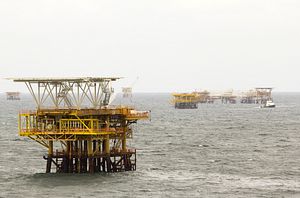China made a startling announcement on Wednesday morning, when Foreign Ministry spokesman Hong Lei told Xinhua News Agency that China National Petroleum Corp.’s HYSY 981 offshore oil rig was leaving its position in waters disputed with Vietnam near the Paracel Islands, which it had occupied since May 2. Since being deployed, the rig has been a constant source of conflict between Vietnam and China, with almost daily naval confrontations between the two countries’ coast guards and fishing fleets, and violent anti-China protests in Vietnam. While this sudden departure is surprising and significant for several reasons, Hong made sure to state that the Xisha, or Paracel, Islands were inherently Chinese territory, and that “China strongly opposes Vietnam’s irrational disruptions and has taken necessary security measures to ensure the operation.”
The decision to take the oil rig to Hainan a full month ahead of schedule raises several questions. CNPC originally stated that the rig would remain at its location until August 15, yet on Tuesday said that both exploration and drilling were complete. The deputy director of CNPC’s Policy Research Office, Wang Zhen, said that preliminary analysis showed that the area had the “the basic conditions and potential for oil exploration, but extraction testing cannot begin before a comprehensive assessment of the data.” Thus China has given itself a reason to return should it want to, but the vague mention of requiring further data assessment before returning to drill means China can decide when or if revisiting this dispute with Vietnam is necessary.
China’s abrupt withdrawal of the rig before its scheduled departure with no advanced warning and very little fanfare would lead to the logical assumption that China is seeking to reduce tension with Vietnam, and is perhaps bending to international pressure over its growing assertive claims to 90 percent of the South China Sea, which has led to increasingly hostile disputes with both Vietnam and the Philippines. That may very well be the case, yet China has left itself with the rationale to return should it choose to.
While not giving an official reason for leaving early, Xinhua noted that the test operations could not be immediately arranged because the typhoon season was beginning. An industry official with knowledge of the operation who spoke with Reuters also noted that leaving early would free the rig to be contracted for other jobs. As China’s most advanced and newest offshore oil platform, capable of drilling twice as deep as China’s other two deep sea rigs, these two reasons make a modicum of sense. China has withdrawn all of the other vessels that it employed to protect the rig and its claim to the disputed waters. According to deputy director of Vietnam’s fisheries resources surveillance department, Ha Le, Vietnam has also removed its 30 coast guard and fisheries patrol vessels in order to avoid Typhoon Rammasun.
It is curious that China has decided to effectively abandon its claim to the Paracel Islands at this point, when its use of ramming and water cannon made the dispute fairly one-sided, as Vietnam suffered 27 damaged boats as well as 15 injured surveillance officers. Even the anti-China protests in Vietnam that escalated during May subsided after the government effectively clamped down, possibly due to Vietnam’s dependence on its economic ties to China and its realization that its navy is no match.
With Vietnam effectively neutralized for the immediate future, the decision to withdraw early is likely due to larger regional tensions. China’s recent nine-dash line assertion in the South China Sea with both Vietnam and the Philippines has been the catalyst for quite a bit of regional security cooperation. China’s largest rival in the region, Japan, has taken the opportunity to pledge coast guard ships and strengthen defense ties with the respective countries. China was also the main target of the Shangri-La Dialogue in late May, with both the U.S. and Japan citing its attempt to change the status quo as the most important current regional trend.
While China appears to be backing off for now, it is likely playing a longer game. It has conceded none of its claims, yet has shown that it can assert its will (at least in regard to the much weaker Vietnam) and complete its objectives despite regional outcries and near daily confrontations. China will likely regard this as setting a successful precedent, whereby it can impose its interpretation of regional boundaries without a significant backlash. Instead of a reduction in Chinese assertiveness, what is equally likely is that the Chinese leadership feels it can revisit issues like this at the time and place of its choosing in the future, and that the regional security balance will not have significantly shifted or solidified against it in the interim. Should that prove not to be the case, then a valuable piece of offshore hardware is safely within its home waters, and China has proven it has the wherewithal to endure sustained regional pressure.

































